Comics in The Avengers
Introduction
The most obvious incarnation of comics in The Avengers is 'The Winged
Avenger', an episode which has a comic strip villain, a comic strip company
and some humour at the expense of then comic book related smash hit series,
Batman. It also has the work of top British comic strip artist, Frank
Bellamy. There's a quick look at Bellamy and his work on The Avengers
below, as well as an attempt to find out which other comics were used
in the making of the episode.
Tintin and the English Gentleman
One of the more endearing of Steed's little quirks is his occasional
habit of picking up a copy of a Tintin book to read. Herge's boy reporter
character first appeared in 1929 in French and then Belgian, but his adventures
weren't regularly translated into English until 1958, and according to
T.F. Mills (http://www.regiments.org/special/essays/tbibeng.htm) "it
took the British edition five years to become a staple part of the children's
book market", so they were at the start of their voyage into the
English consciousness when Steed first picked them up.
| The first example is in 'The Golden Fleece', where we
find Steed reading "Tintin au Pays de L'Or Noir" (Tintin
in the Land of Black Gold) in the original French. It was not available
in English at the time the episode was made. |
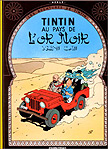 |
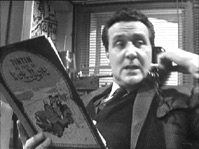 |
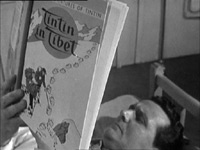 |
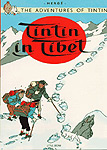 |
He reads "Tintin in Tibet" (in English) in
his chalet at the holiday camp in "Man with Two Shadows. This
volume was one of the original wave of Methuen Books translations
in 1958. |
| He also reads "Tintin : Le Lotus Bleu" (again,
in French) in the tag scene of the Tara episode "Look- (stop
me if you've heard this one) but there were these two fellers...".
Incredibly, this was not translated into English until 1983 due to
the publishers believing the story was too problematic for its intended
readership. |
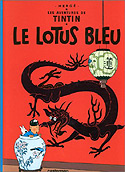 |
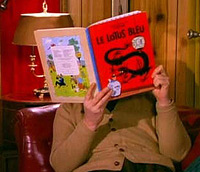 |
Thanks to George and Piers. Great minds do think alike.
The Winged Avenger
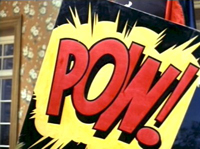 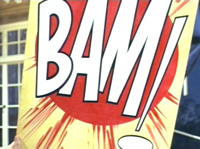 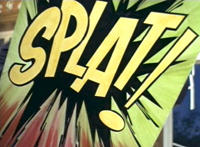
Steed Goes Birdwatching... Emma Does A Comic Strip
Filmed in December 1966, 'The Winged Avenger' is the most celebrated
example of comic strips in The Avengers. Written by Gordon Flemyng and
Peter Duffell and directed by Richard Harris it features Steed and Mrs.
Peel at their 60s Pop Op Mod Art best. The illustrations for the full
screen illustrations which lead out into scenes were drawn by celebrated
British comic artist Frank Bellamy.
Run your mouse over the panels with
a blue border to get the full effect.
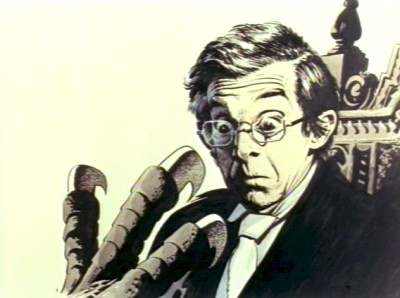
Poole is surprised by The Winged Avenger
The story itself is no great shakes, but the gimmick of
having the comic book panels fade into the live action was something which
greatly impressed me on first seeing it. That they also got in an artist
of the calibre of Frank Bellamy was either superb taste or extremely good
luck. It's difficult to see how it would have worked so well with other
British artists of the time as Bellamy's photo-realistic style suits the
purpose to a 'T'.
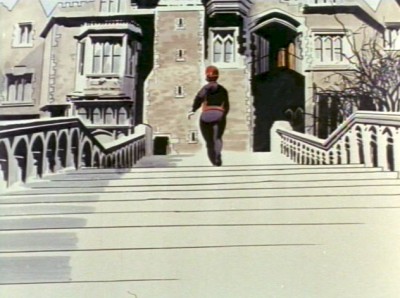
Emma visits Sir Lexius Cray.
Frank Bellamy
Frank Bellamy was born in Kettering in 1917 and worked as
an illustrator in a post-war advertising agency. Following a stint as
a gag/editorial cartoonist for a local newspaper during the war years
he moved to London in 1949, intending to make a go of at as a freelance
illustrator. Initially working on spot illustrations for women's magazine
'Home Notes', he managed to get work on the relatively expensively-printed
'Mickey Mouse Weekly' on the back of an advertising job for Gibbs toothpaste.
This led to work for Swift, the 'younger readers' equivalent of the then
ground-breaking and extremely popular Eagle comic.
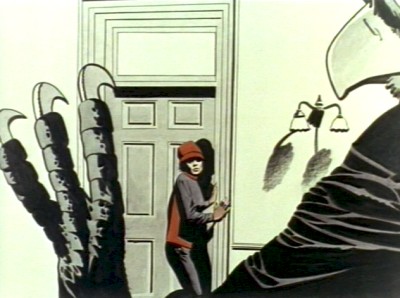
Emma is menaced by The Winged Avenger
Bellamy worked on strips for Swift (including Swiss Family
Robinson and Robin Hood and his Merrie Men) until 1957 when he made the
logical leap sideways and began to work for The Eagle. Like Mickey Mouse
Weekly, The Eagle was printed, unlike many of the other comics of the
period, to a very high standard using the photogravure process and on
a relatively high standard of paper stock. Without this quality, much
of the printed detail of Bellamy's work would have been lost.
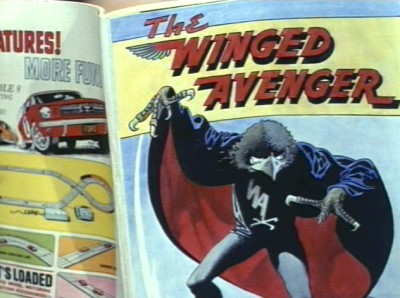
Bellamy's cover for 'The Winged Avenger'
For The Eagle, Bellamy worked on 'The Happy Warrior' a one-page
full-colour weekly strip relating the life of Winston Churchill, which
was very successful and links him with Patrick Macnee who worked on 'The
Valiant Years' a TV documentary series based on Churchill's memoirs. Bellamy
also worked on 'Fraser of Africa', 'Heros The Spartan' and a revamp of
the title's most-popular character, Dan Dare, which caused uproar due
to Bellamy's refusal to look backwards.
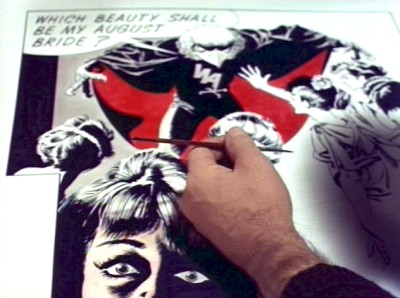
'Arnie Packer' works on a Frank Bellamy illustration
Bellamy's next work was for the Gerry Anderson comic TV
Century 21, for who he produced a 'Thunderbirds' strip so dynamic it was
almost possible to view the show as one which used actors rather than
puppets (even though the likenesses of the puppets were retained!). Following
the closure of TV Century 21 Bellamy took on more straightforward illustration
work (this had continued during his stint on TV Century 21 as he drew
a number of comic strip adaptations of Hammer films for The Daily Record
in Scotland), including some Doctor Who illustrations for The Radio Times
which were subsequently collected into a book. In 1971 he began illustrating
'Garth', a daily strip in The Daily Mirror newspaper; it was his last
major piece and he died in 1976, while still working on it.
Read more about Frank Bellamy here.
Hawkaaaaa!! The Avengers and Blackhawk
Not all the strip illustrations for 'The Winged Avenger'
were produced by Frank Bellamy. The one below is adapted (ie somebody
has drawn on top of a panel) from an issue of 'Blackhawk', published in
the USA by DC Comics. It would be interesting to find out which issue
it was, and if anybody has the time, the inclination and (most importantly)
the Blackhawk collection to do so it would be a welcome addition, especially
if it was confirmed that it was the same US comic which acted as a base
for 'The Winged Avenger' (see screen grab of comic above with US toy car
track advert on the back cover).
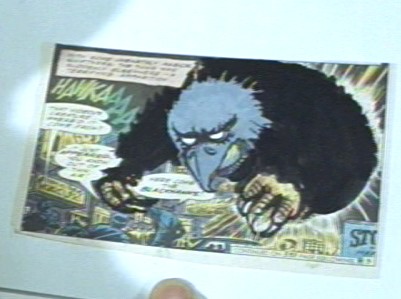
The Blackhawks can be seen in the bottom left corner of
the panel
Thanks to David for the scans.
|

